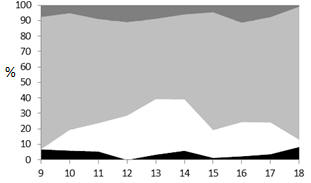Ver ítem
- xmlui.general.dspace_homeCentros Regionales y EEAsCentro Regional Patagonia SurEEA Santa CruzArtículos científicosxmlui.ArtifactBrowser.ItemViewer.trail
- Inicio
- Centros Regionales y EEAs
- Centro Regional Patagonia Sur
- EEA Santa Cruz
- Artículos científicos
- Ver ítem
Landscape heterogeneity influences on sheep habits under extensive grazing management in Southern Patagonia
Resumen
In Southern Patagonia, continuous grazing with fixed stocking rates in large paddocks prevails over grazing systems subjected to regular evaluations and rotational rests. Because of this, sheep extensive systems need technologies to improve their production levels under sustainable management. In this context, the aim of this work was to provide knowledge of sheep habits (diet, daily activity and spatial distribution patterns) in seven paddocks at a
[ver mas...]
In Southern Patagonia, continuous grazing with fixed stocking rates in large paddocks prevails over grazing systems subjected to regular evaluations and rotational rests. Because of this, sheep extensive systems need technologies to improve their production levels under sustainable management. In this context, the aim of this work was to provide knowledge of sheep habits (diet, daily activity and spatial distribution patterns) in seven paddocks at a production scale throughout the year in Southern Patagonia. The area is an extensive ecotone between forest and steppe, characterized by a rugged landscape with valleys and mountains.
Three vegetation types were distinguished in each paddock: forest, steppe and wetland. After a two years trial, sheep showed an important array of strategies for facing restrictions imposed by climate and low forage availability. A strong dietary selectivity, a high percentage of time allocated to grazing, large explored areas and opportunistic selection of vegetation types explained the capacity for reproduction under Southern Patagonia harsh conditions. The application of an intensified management involving paddock subdivision and separation of vegetation types should consider how sheep grazing strategies are limited.
[Cerrar]

Fuente
Livestock research for rural development 27 (6). (2015)
Fecha
2015
ISSN
0121-3784
Formato
pdf
Tipo de documento
artículo
Palabras Claves
Derechos de acceso
Abierto
 Excepto donde se diga explicitamente, este item se publica bajo la siguiente descripción: Creative Commons Attribution-NonCommercial-ShareAlike 2.5 Unported (CC BY-NC-SA 2.5)
Excepto donde se diga explicitamente, este item se publica bajo la siguiente descripción: Creative Commons Attribution-NonCommercial-ShareAlike 2.5 Unported (CC BY-NC-SA 2.5)


